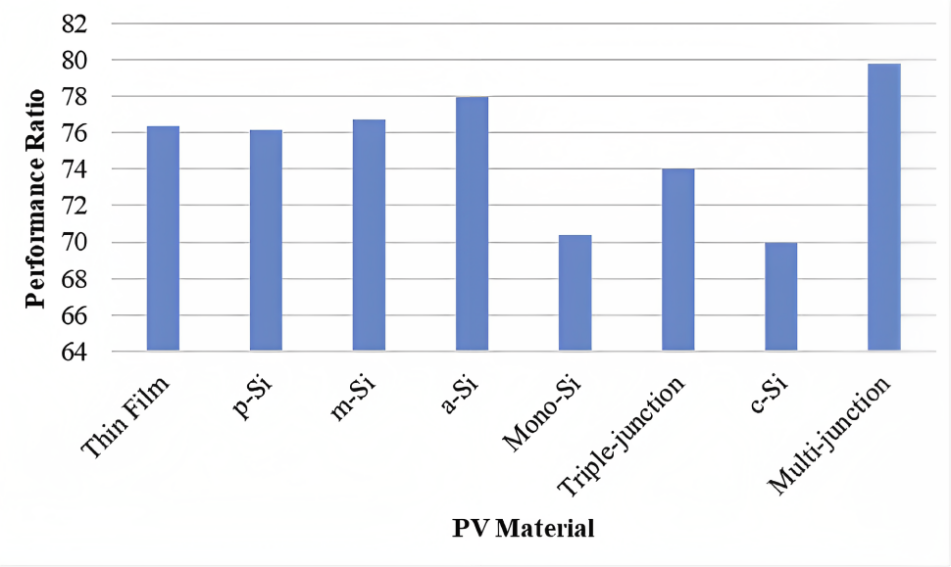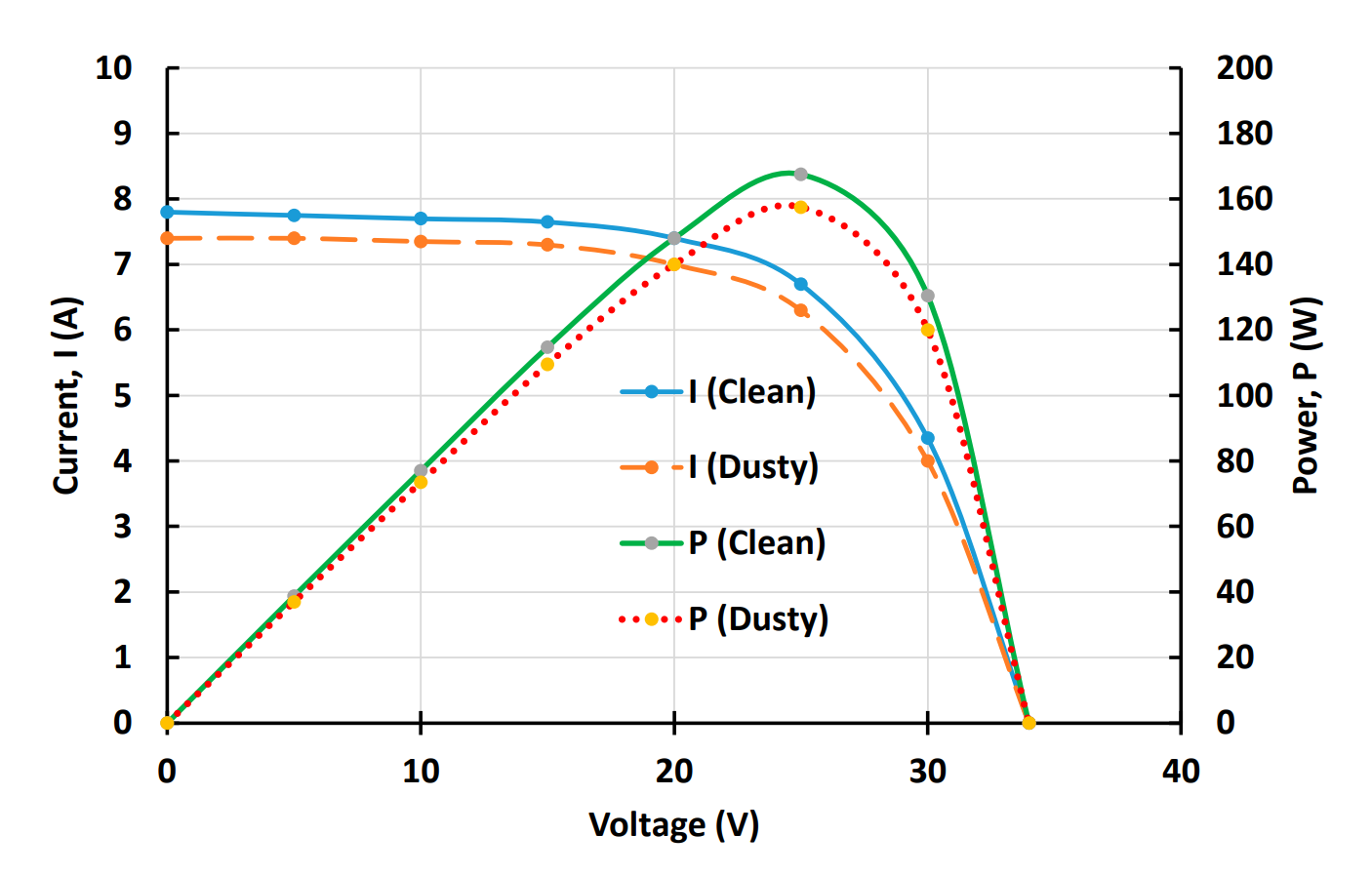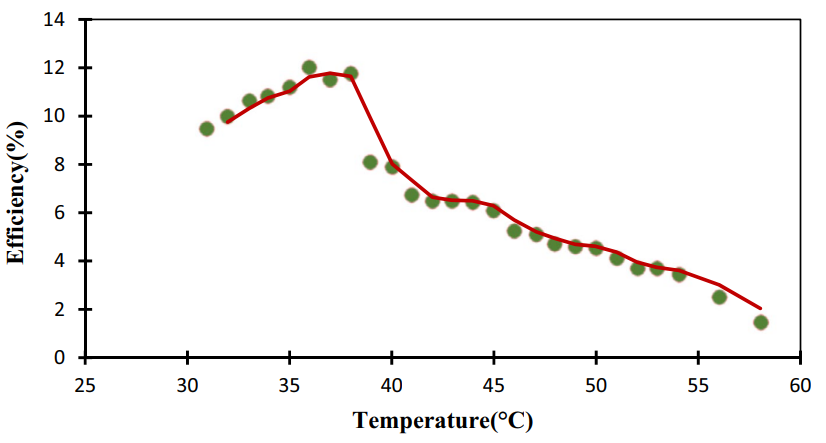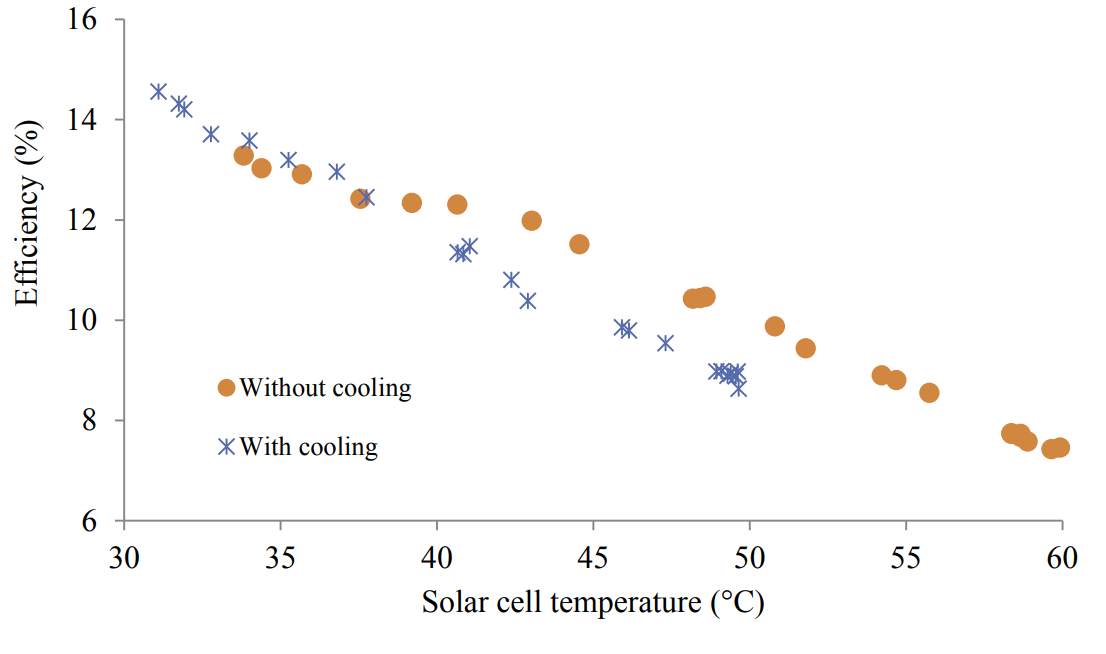1. Introduction
The utilization of solar cells as a viable renewable source of energy has garnered significant attention in recent years. Solar cells are categorized into three main types, namely, silicon-based solar cells, thin-film solar cells, and calcium titanium ore solar cells [1]. Each of these solar cell types possesses its unique strengths and weaknesses. Environmental factors, such as dust accumulation, ambient temperature, shading, and angle of incidence, can significantly impact the generation of electricity by PV systems.
Dust accumulated over time on the photovoltaic (PV) panel will have a significant impact on the efficiency of the PV system. This is because it can hinder the transmission of solar radiation, create non-uniform shading, and diminish the modules' capacity to dissipate heat. High temperatures can also negatively impact the PV system's operation by reducing the operating voltage of the cells, while shading can block sunlight, thus reducing the output power of the PV system. Additionally, humidity can cause minute droplets of water to accumulate on solar panels, refracting, reflecting or diffracting sunlight, which reduces the solar radiation received. Therefore, comprehending the impact of these environmental factors on solar cells is of paramount importance for monitoring their quality and assessing their performance [2].
This paper aims to investigate the impact of environmental factors on solar cells, focusing on dust, temperature, and humidity. Through a comprehensive analysis of existing literature and empirical studies, this paper seeks to provide a deeper understanding of the effect of these factors on the performance of solar cells. The findings of this study can provide valuable insights into improving the efficiency and durability of solar cells, ultimately contributing to the widespread adoption of this renewable energy source.
2. Overview of solar cell technology
There exist three diverse classes of solar cells. Silicon-based solar cells are fashioned using silicon materials and come in two forms: monocrystalline silicon PV cells and polycrystalline silicon PV cells. Monocrystalline silicon cells have been shown to have the higher efficiency, reaching 26.7% in laboratory assessments [1]. Nevertheless, their steep cost and intricate manufacturing process have made them arduous to be widely embraced. They are manufactured via a similar process to monocrystalline cells but with multiple crystalline grains, resulting in a lower efficiency level. Despite having higher production costs, monocrystalline cells are still the most dominant product in the PV market due to their extended service life, impeccable preparation process, and high conversion efficiency. Even though the cost of manufacturing monocrystalline PV cells is only 30% of the total module cost, they continue to be the most favored preference [2].
Thin-film solar cells are composed of economical materials and can be generated using various substrates like ceramics, metal sheets, and graphite. There are several types of thin-film solar cells, each with unique properties and advantages. Among the primary variants are amorphous silicon (α-Si), which is a non-crystalline form of silicon that is flexible and lightweight, making it ideal for applications where weight and flexibility are important factors. Finally, there is cadmium telluride (CdTe), which is a low-cost and efficient option that is widely used in utility-scale solar power plants. These cells necessitate only a minimal amount of PV material and are several microns thick, which makes them simple to manufacture. Moreover, they exhibit satisfactory performance even under high ambient temperatures. Nevertheless, their conversion efficiency must be improved since some of their constituent elements such as tellurium, indium, and gallium are scarce and have limited reserves, while others like cadmium and selenium are hazardous and can potentially pollute the environment [2].
Chalcogenide solar cells are a promising type of solar cell that are composed of a mix of organic and inorganic halides known as ABX3. The ABX3 mix consists of different cations of varying sizes, with A being larger than B, and an anion represented by X. These solar cells are highly efficient and have the potential to become one of the most efficient types of solar cells available. Unfortunately, the stability of perovskite solar cells (PSCs) remains a concern. Multiple types of degradation can occur simultaneously at different interfaces within the device [3]. PSCs are still not stable enough due to various forms of degradation that can take place within the device, caused by factors such as crystal structure instability, photodegradation, and moisture-induced top electrode instability. To improve the stability of PSCs, researchers are investigating different approaches [4].
3. Non-environmental factors
While environmental factors are important to PV systems, there are also non-environmental factors to consider. The series and shunt resistances of PV cells can result in I^2R losses, decreasing module efficiency [5].
Perovskite instability is another factor that can affect PV systems. It is nearly impossible to avoid ion migration in halide perovskites because of high external fields and ionic mobility, particularly at defective sites, grain boundaries, and interfaces [6].
Various PV technologies are accessible in the market, each possessing distinct attributes, that render them suitable for specific geographic regions [7]. In Morocco, researchers compared three PV technologies and found that monocrystalline silicon had the best energy production and performance ratio [8]. Figures 1 displays the comparison of performance ratios among various PV technologies.

Figure 1. Comparison of performance ratios among various PV technologies [9].
4. Environmental factors
The impact of dust on PV panels is a significant concern. It can impede the transmittance of solar radiation, leading to a reduction in output power [10]. The non-uniform shading caused by dust accumulation can also cause a mismatch of PV modules, further reducing the output power. Additionally, some types of dust can cause corrosion and amplify the diffuse reflection of sunlight, further curtailing light transmission [11].
The ambient temperature is another environmental factor. When the temperature rises, the surface temperature of PV modules also increases, resulting in a reduction in operating voltage and output power [12].
Humidity can cause reduction the amount of direct solar radiation. Prolonged exposure to humid air can also corrode PV modules and amplify material conductivity and leakage current [13].
The angle of inclination of PV modules is also significant in optimizing solar radiation absorption. Deviation from the latitude angle can decrease solar radiation absorption.
Shading caused by various structures or natural elements, such as trees and leaves, can block sunlight and reduce the output power.
Finally, solar irradiance is directly linked to the energy production. PV modules should be directed towards the sun to achieve maximum power output. Understanding these environmental factors is crucial for monitoring quality and assessing performance.
4.1. The impact of dust on solar cell efficiency and performance
Dust refers to tiny solid particles which has a diameter of less than 500 µm. Such particles can originate from a range of sources, including wind, people and vehicular movement, volcanic eruptions, and different forms of pollution. The settling of dust on surfaces, including PV modules, depends on various sources and can be removed quickly or accumulate over time, influenced by wind speed [11].
In a previous study, the researchers assessed the situation of dust grains deposition of PV modules in a simulated airflow environment. Results from these studies indicate that the wind direction significantly impacted dust settling more than air velocity [14, 15]. Additionally, the amount of dust accumulated on PV surfaces was found to vary based on the direction of the wind and the orientation of the surfaces. Studies have shown that fine dust particles in solar panels can significantly degrade performance than larger particles [16]. Figure 2 displays the comparison between the two curves provides a clear representation of the influence of dust [10]. Kohli and Mittal conducted research which revealed that dust particles smaller than 50 µm in size exhibited increased resistance to wind forces, making it more difficult for them to be cleared away. This finding suggests that smaller dust particles are more likely to accumulate on surfaces such as solar PV panels, which can have negative effects on their performance [17].

Figure 2. Comparing output power variation between clean and dusty panels [10].
4.2. The impact of temperature on solar cell efficiency and performance
The power generation efficiency of solar panels is affected by their temperature [18]. When the panel temperature rises, less solar energy is converted into electricity and more is converted into heat [19]. The bandgap energy of the PV cell material, which determines the photons that can be absorbed, is strongly influenced by temperature. At high temperatures, the bandgap energy decreases. However, this only slightly increases the generated current, causing the open circuit voltage to drop and lowering the cell fill factor [20]. Figure 3 and Figure 4 illustrate the effects of ambient and cell temperatures on a PV system's performance. Stability of PSCs is key to high performance, but lead-based PSCs are often rapidly degraded. On the other hand, tin-based perovskites are more stable, but their stability is affected by both extrinsic and intrinsic factors, such as the presence of oxygen and moisture [6].

Figure 3. Effect of module temperature on efficiency [21].

Figure 4. Solar cell temperature versus efficiency curve [19].
4.3. The impact of humidity on solar cell efficiency and performance
When water encounters the cell component of the cell, the efficiency of the PV unit is adversely affected, resulting in a decrease in electrical productivity. Besides corroding metal joints, water can spoil the viscosity of batteries [22]. Relative humidity (RH) is directly influenced by temperature, which in turn affects the water vapor saturation pressure and causes variations [23, 24]. In regions with high temperatures and humidity, the presence of cracks in PV cells can allow moisture to seep into the cells. This infiltration of moisture can result in significant degradation of cell productivity and efficiency. The impact of moisture can be described as a slow process because it can take a significant amount of time before any noticeable effects become apparent [25]. The layer of polymer can be permeated by moisture, causing damage to interconnecting bonds and corrosion of weld joints [26]. Numerous studies examined the impact of varying air humidity levels on solar cells, although this effect cannot be studied without considering other climatic variables [27].
Sn-based PSCs have been limited by their thermal instability, resulting in poor performance. This instability is often due to the annealing process, which exposes the perovskite layers to high temperatures, leading to degradation and reduced efficiency [28]. Moreover, solar cells that operate above 25°C experience decreased performance. Relative humidity is another factor that can affect solar cells, particularly when combined with other weather conditions like atmospheric temperature, dust, and rain. The corrosion of solar cells by relative humidity is significant, high air temperatures and humidity can not only decrease the cell's performance but also shorten its lifespan. In addition, relative humidity levels above 75% are conducive to fungal growth, which may further impair the performance of solar cells [29].
5. Conclusion
To be brief, the utilization of solar cells as a renewable energy is becoming increasingly popular. However, the efficiency and durability of solar cells are significantly impacted by various environmental factors, including dust accumulation, ambient temperature, shading, solar irradiance, and humidity. This paper has investigated the impact of these factors on solar cell performance, focusing on their mechanisms and effects. Understanding these factors is critical to improving the durability of solar cells and ultimately promoting the widespread adoption of this renewable energy source.
Looking into the future, research on exploring the stability of solar cells will continue. One area of focus will be the development of more stable and efficient solar cell technologies that can withstand various environmental factors. Additionally, researchers will explore ways to optimize the manufacturing process of solar cells to reduce costs and improve efficiency. Furthermore, there will be an increased focus on the use of artificial intelligence and machine learning to monitor and optimize the performance of solar cells, as well as to predict and mitigate the impact of environmental factors. Overall, solar energy is a crucial solution to reducing greenhouse gas emissions, and further advancements in solar cell technology will play a significant role in achieving a sustainable future.
References
[1]. Dazhou Y, Yanmin L and Ye W. (2021). Effect and impact of crystalline silicon solar energy in the" double carbon" economy, China Nonferrous Metallurgy, 50(5), 1-6.
[2]. QingYan X, YuanWen R and Shimin L. (2020). Progress in solar cell research, Journal of Functional Materials and Devices (04), 257-262.
[3]. Edri E, Kirmayer S, Henning A, Mukhopadhyay S, Gartsman K, Rosenwaks Y, Hodes G, Cahen D. (2014) Why lead methylammonium tri-iodide perovskite-based solar cells require a mesoporous electron transporting scaffold (but not necessarily a hole conductor), Nano Lett. 14(2):1000-4.
[4]. Aftab A and Ahmad M I. (2021) A review of stability and progress in tin halide perovskite solar cell, Solar energy, 216, pp. 26–47.
[5]. Vidyanandan K V (2017). An overview of factors affecting the performance of solar PV systems, Energy Scan, 27(28), 216.
[6]. Meng L, You J. and Yang Y. (2018) Addressing the stability issue of perovskite solar cells for commercial applications, Nature communications, 9(1), pp. 5265–4.
[7]. Udayakumar M D et al. (2021) The impact of advanced technological developments on solar PV value chain, in Materials today: proceedings. Elsevier Ltd, pp. 2053–2058.
[8]. Ameur A, Sekkat A, Loudiyi K and Aggour M. (2019). Performance evaluation of different photovoltaic technologies in the region of Ifrane, Morocco, Energy for Sustainable Development, 52, 96-103.
[9]. Srivastava R, Tiwari A N and Giri V K. (2020) An overview on performance of PV plants commissioned at different places in the world, Energy for sustainable development, 54, pp. 51–59.
[10]. Vedulla G, Geetha A and Senthil R. (2023) Review of Strategies to Mitigate Dust Deposition on Solar Photovoltaic Systems, Energies (Basel), 16(1), p. 109.
[11]. Mani M and Pillai R. (2010) Impact of dust on solar photovoltaic (PV) performance: Research status, challenges and recommendations, Renewable & sustainable energy reviews, 14(9), pp. 3124–3131.
[12]. Aslam A et al. (2022) Advances in Solar PV Systems; A Comprehensive Review of PV Performance, Influencing Factors, and Mitigation Techniques, Energies (Basel), 15(20), p. 7595.
[13]. Hasan K et al. (2022) Effects of different environmental and operational factors on the PV performance: A comprehensive review, Energy science & engineering, 10(2), pp. 656–675.
[14]. Goossens D and Offer Z Y. (1995) Comparisons of day-time and night-time dust accumulation in a desert region, Journal of arid environments, 31(3), pp. 253–281.
[15]. Goossens D. (1991) Aeolian dust ripples: Their occurrence, morphometrical characteristics, dynamics and origin, Catena (Giessen), 18(3), pp. 379–407.
[16]. Elminir H K et al. (2006) Effect of dust on the transparent cover of solar collectors, Energy conversion and management, 47(18), pp. 3192–3203.
[17]. Kohli R and Mittal K L. (2011) Methods for Removal of Particle Contaminants, In Developments in Surface Contamination and Cleaning; William Andrew Publishing: Norwich, UK, Volume 3.
[18]. Coskun C et al. (2017) Sensitivity analysis of implicit correlations for photovoltaic module temperature: A review, Journal of cleaner production, 164, pp. 1474–1485.
[19]. Rahman M M, Hasanuzzaman M and Rahim N A. (2017) Effects of operational conditions on the energy efficiency of photovoltaic modules operating in Malaysia, Journal of cleaner production, 143, pp. 912–924.
[20]. Meyer E L and van Dyk E E. (2004) Assessing the reliability and degradation of photovoltaic module performance parameters, IEEE transactions on reliability, 53(1), pp. 83–92.
[21]. Katkar A A, Shinde N N and Patil P S. (2011). Performance & evaluation of industrial solar cell w.r.t. temperature and humidity, International Journal of Research in mechanical engineering and Technology, 1(1), 69-73.
[22]. Koehl M, Heck M and Wiesmeier S. (2012) Modelling of conditions for accelerated lifetime testing of Humidity impact on PV-modules based on monitoring of climatic data, Solar energy materials and solar cells, 99, pp. 282–291.
[23]. Elminir H K, Benda V and Tousek J. (2001). Effects of solar irradiation conditions and other factors on the outdoor performance of photovoltaic modules, JOURNAL OF ELECTRICAL ENGINEERING-BRATISLAVA-, 52(5/6), 125-133.
[24]. Kempe M D. (2006) Modeling of rates of moisture ingress into photovoltaic modules Solar energy materials and solar cells, 90(16), pp. 2720–2738.
[25]. Fanney A H, Davis M W, Dougherty B P, King D L, Boyson W E, and Kratochvil J A. (2006). Comparison of Photovoltaic Module Performance Measurements, ASME. J. Sol. Energy Eng. May 2006; 128(2): 152–159.
[26]. Bhattacharya P, Dey S and Mustaphi B. (2014) Some Analytical Studies on the Performance of Grid Connected Solar Photovoltaic System with Different Parameters, Procedia materials science, 6, pp. 1942–1950.
[27]. Morita K, Inoue T, Kato H, Tsuda I and Hishikawa Y. (2003) Degradation factor analysis of crystalline-Si PV modules through long-term field exposure test, 3rd World Conference onPhotovoltaic Energy Conversion. Proceedings of, Osaka, 2003, pp. 1948-1951 Vol.2.
[28]. Aftab A and Ahmad M I (2021) A review of stability and progress in tin halide perovskite solar cell, Solar energy, 216, pp. 26–47.
[29]. Prakash J K, Gopinath N and Kirubakaran V. (2014). Optimization of solar PV panel output: A viable and cost effective solution, In International Journal of Advanced Technology & Engineering Research (IJATER) National Conference on “Renewable Energy Innovations for Rural Development” ISSN, No. 2250-3536, pp. 20.
Cite this article
Yang,Z. (2023). A comprehensive analysis of environmental factors affecting solar cells: Dust accumulation, ambient temperature, and humidity. Applied and Computational Engineering,23,216-222.
Data availability
The datasets used and/or analyzed during the current study will be available from the authors upon reasonable request.
Disclaimer/Publisher's Note
The statements, opinions and data contained in all publications are solely those of the individual author(s) and contributor(s) and not of EWA Publishing and/or the editor(s). EWA Publishing and/or the editor(s) disclaim responsibility for any injury to people or property resulting from any ideas, methods, instructions or products referred to in the content.
About volume
Volume title: Proceedings of the 2023 International Conference on Functional Materials and Civil Engineering
© 2024 by the author(s). Licensee EWA Publishing, Oxford, UK. This article is an open access article distributed under the terms and
conditions of the Creative Commons Attribution (CC BY) license. Authors who
publish this series agree to the following terms:
1. Authors retain copyright and grant the series right of first publication with the work simultaneously licensed under a Creative Commons
Attribution License that allows others to share the work with an acknowledgment of the work's authorship and initial publication in this
series.
2. Authors are able to enter into separate, additional contractual arrangements for the non-exclusive distribution of the series's published
version of the work (e.g., post it to an institutional repository or publish it in a book), with an acknowledgment of its initial
publication in this series.
3. Authors are permitted and encouraged to post their work online (e.g., in institutional repositories or on their website) prior to and
during the submission process, as it can lead to productive exchanges, as well as earlier and greater citation of published work (See
Open access policy for details).
References
[1]. Dazhou Y, Yanmin L and Ye W. (2021). Effect and impact of crystalline silicon solar energy in the" double carbon" economy, China Nonferrous Metallurgy, 50(5), 1-6.
[2]. QingYan X, YuanWen R and Shimin L. (2020). Progress in solar cell research, Journal of Functional Materials and Devices (04), 257-262.
[3]. Edri E, Kirmayer S, Henning A, Mukhopadhyay S, Gartsman K, Rosenwaks Y, Hodes G, Cahen D. (2014) Why lead methylammonium tri-iodide perovskite-based solar cells require a mesoporous electron transporting scaffold (but not necessarily a hole conductor), Nano Lett. 14(2):1000-4.
[4]. Aftab A and Ahmad M I. (2021) A review of stability and progress in tin halide perovskite solar cell, Solar energy, 216, pp. 26–47.
[5]. Vidyanandan K V (2017). An overview of factors affecting the performance of solar PV systems, Energy Scan, 27(28), 216.
[6]. Meng L, You J. and Yang Y. (2018) Addressing the stability issue of perovskite solar cells for commercial applications, Nature communications, 9(1), pp. 5265–4.
[7]. Udayakumar M D et al. (2021) The impact of advanced technological developments on solar PV value chain, in Materials today: proceedings. Elsevier Ltd, pp. 2053–2058.
[8]. Ameur A, Sekkat A, Loudiyi K and Aggour M. (2019). Performance evaluation of different photovoltaic technologies in the region of Ifrane, Morocco, Energy for Sustainable Development, 52, 96-103.
[9]. Srivastava R, Tiwari A N and Giri V K. (2020) An overview on performance of PV plants commissioned at different places in the world, Energy for sustainable development, 54, pp. 51–59.
[10]. Vedulla G, Geetha A and Senthil R. (2023) Review of Strategies to Mitigate Dust Deposition on Solar Photovoltaic Systems, Energies (Basel), 16(1), p. 109.
[11]. Mani M and Pillai R. (2010) Impact of dust on solar photovoltaic (PV) performance: Research status, challenges and recommendations, Renewable & sustainable energy reviews, 14(9), pp. 3124–3131.
[12]. Aslam A et al. (2022) Advances in Solar PV Systems; A Comprehensive Review of PV Performance, Influencing Factors, and Mitigation Techniques, Energies (Basel), 15(20), p. 7595.
[13]. Hasan K et al. (2022) Effects of different environmental and operational factors on the PV performance: A comprehensive review, Energy science & engineering, 10(2), pp. 656–675.
[14]. Goossens D and Offer Z Y. (1995) Comparisons of day-time and night-time dust accumulation in a desert region, Journal of arid environments, 31(3), pp. 253–281.
[15]. Goossens D. (1991) Aeolian dust ripples: Their occurrence, morphometrical characteristics, dynamics and origin, Catena (Giessen), 18(3), pp. 379–407.
[16]. Elminir H K et al. (2006) Effect of dust on the transparent cover of solar collectors, Energy conversion and management, 47(18), pp. 3192–3203.
[17]. Kohli R and Mittal K L. (2011) Methods for Removal of Particle Contaminants, In Developments in Surface Contamination and Cleaning; William Andrew Publishing: Norwich, UK, Volume 3.
[18]. Coskun C et al. (2017) Sensitivity analysis of implicit correlations for photovoltaic module temperature: A review, Journal of cleaner production, 164, pp. 1474–1485.
[19]. Rahman M M, Hasanuzzaman M and Rahim N A. (2017) Effects of operational conditions on the energy efficiency of photovoltaic modules operating in Malaysia, Journal of cleaner production, 143, pp. 912–924.
[20]. Meyer E L and van Dyk E E. (2004) Assessing the reliability and degradation of photovoltaic module performance parameters, IEEE transactions on reliability, 53(1), pp. 83–92.
[21]. Katkar A A, Shinde N N and Patil P S. (2011). Performance & evaluation of industrial solar cell w.r.t. temperature and humidity, International Journal of Research in mechanical engineering and Technology, 1(1), 69-73.
[22]. Koehl M, Heck M and Wiesmeier S. (2012) Modelling of conditions for accelerated lifetime testing of Humidity impact on PV-modules based on monitoring of climatic data, Solar energy materials and solar cells, 99, pp. 282–291.
[23]. Elminir H K, Benda V and Tousek J. (2001). Effects of solar irradiation conditions and other factors on the outdoor performance of photovoltaic modules, JOURNAL OF ELECTRICAL ENGINEERING-BRATISLAVA-, 52(5/6), 125-133.
[24]. Kempe M D. (2006) Modeling of rates of moisture ingress into photovoltaic modules Solar energy materials and solar cells, 90(16), pp. 2720–2738.
[25]. Fanney A H, Davis M W, Dougherty B P, King D L, Boyson W E, and Kratochvil J A. (2006). Comparison of Photovoltaic Module Performance Measurements, ASME. J. Sol. Energy Eng. May 2006; 128(2): 152–159.
[26]. Bhattacharya P, Dey S and Mustaphi B. (2014) Some Analytical Studies on the Performance of Grid Connected Solar Photovoltaic System with Different Parameters, Procedia materials science, 6, pp. 1942–1950.
[27]. Morita K, Inoue T, Kato H, Tsuda I and Hishikawa Y. (2003) Degradation factor analysis of crystalline-Si PV modules through long-term field exposure test, 3rd World Conference onPhotovoltaic Energy Conversion. Proceedings of, Osaka, 2003, pp. 1948-1951 Vol.2.
[28]. Aftab A and Ahmad M I (2021) A review of stability and progress in tin halide perovskite solar cell, Solar energy, 216, pp. 26–47.
[29]. Prakash J K, Gopinath N and Kirubakaran V. (2014). Optimization of solar PV panel output: A viable and cost effective solution, In International Journal of Advanced Technology & Engineering Research (IJATER) National Conference on “Renewable Energy Innovations for Rural Development” ISSN, No. 2250-3536, pp. 20.









